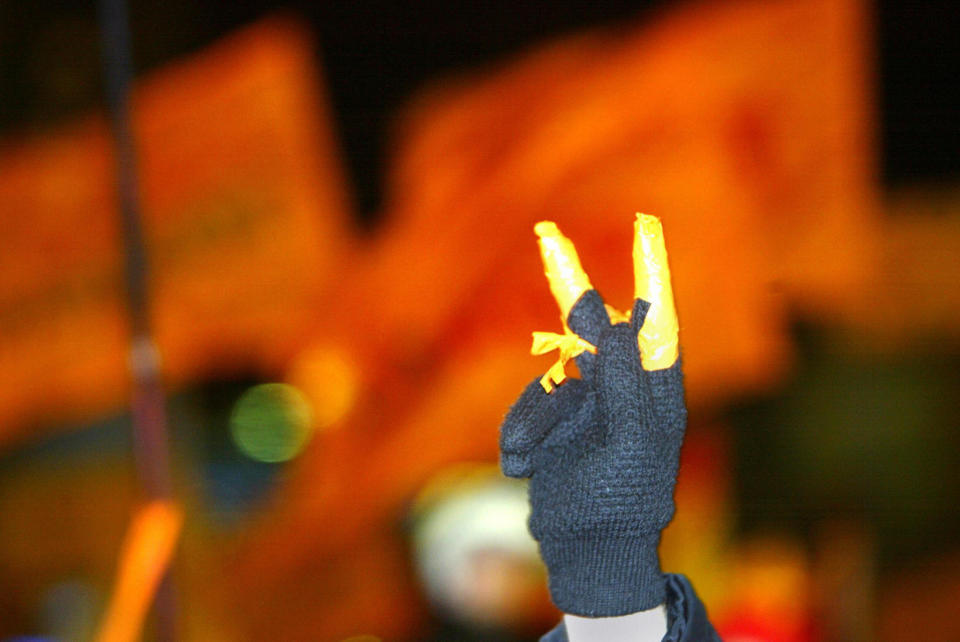Conservatives claim Trump is target of 'color revolution'

Fox News and other conservative media began circulating a new talking point last week in the ongoing effort to sow doubt about the upcoming presidential election, warning that Democratic operatives and government insiders are plotting a “color revolution” to overthrow Trump in November.
“Color revolutions” is the term used for popular uprisings against authoritarian regimes, such as those that took place in former Soviet countries such as Ukraine and Georgia in the early and mid-2000s. Though it’s likely an unfamiliar term for most Americans, the recent warnings from Trump allies about an American color revolution set off alarm bells for some experts on the topic.
“Of all the Kremlin talking points these guys have recycled, I didn’t think I’d ever see this one picked up. I was wrong,” tweeted Michael Carpenter, senior director of the Biden Center for Diplomacy and Global Engagement at the University of Pennsylvania.
“Russian President Vladimir Putin and Chinese President Xi Jinping harbor deep fears of ‘color revolution’ and consequently their regimes are laser-focused on repressing spontaneous popular protests,” Carpenter, who previously served in the Pentagon as a deputy assistant secretary of defense focusing on Russia and the surrounding region, wrote in a message to Yahoo News. “That’s why it’s so jarring, even chilling, to hear fears of color revolution being articulated in the U.S. context.”
Republicans in the past have been especially supportive of some of the color revolutions, such as those in Georgia and Ukraine, particularly during the George W. Bush administration.
In an interview with Fox News host Tucker Carlson last Tuesday, former Trump speechwriter Darren Beattie described “color revolutions” as a “regime change model favored by many in our national security apparatus, particularly against Eastern European countries, to overthrow target regimes they don’t like.”
Beattie, who was reportedly fired from the White House in 2018 after CNN revealed that he’d previously spoken at a conference attended by well-known white nationalists, said the “chief characteristics” of color revolutions include “an engineered contested election scenario combined with massive mobilized protests.”
“Literally the same people ... who have a long history of using these same tactics against foreign regimes they don’t like” are now using them to overthrow “democratically elected President Donald Trump,” Beattie said. “What’s unfolding before our eyes is a very specific type of coup.”
Over the last several weeks, Beattie has been weaving together a sprawling and complex theory involving, among others, current and former State Department officials, Black Lives Matter activists and, of course, George Soros, in a series of articles on the conservative Revolver News site.

Following Beattie’s Tucker Carlson appearance, Mike Huckabee summarized the ex-Trump staffer’s theory in a post on his own website titled “Getting specific about the left’s ‘Color Revolution’ Plan.”
Meanwhile, in a roughly 50-minute video posted to YouTube and the Blaze, conservative commentator and conspiracy theorist Glenn Beck used three large chalkboards to connect many of the same dots. “We all need to be familiar with these two words: color revolution,” Beck told his audience in the video, accompanied by an image of the White House in flames beneath the words “America’s End?”
Other pro-Trump personalities on the far right, such as Jack Posobiec and Michelle Malkin, proceeded to perpetuate the “color revolution” claims on social media.
Nina Jankowicz, a fellow at the Wilson Center in Washington, D.C., said she was “shocked” to see references to “color revolution” on social media in the context of the United States.
Jankowicz studies the intersection of democracy and technology in Central and Eastern Europe, and recently published a book called “How to Lose the Information War: Russia, Fake News, and the Future of Conflict.” She told Yahoo News that color revolutions like those in Georgia and Ukraine “have earned a sinister connotation thanks to Vladimir Putin” because they “brought in more democratically minded governments that threatened Russian influence in the post-Soviet region.”
Jankowicz said the Trump camp’s characterizations of such movements echo those of Putin, who, she said, “likes to suggest they are CIA-organized, robbing protesters of their agency and discounting the real grievances that brought them to the streets in the first place.”

Mark MacKinnon, a senior international correspondent for the Canadian newspaper the Globe and Mail who wrote a book on democratic revolutions in the former Soviet Union, attempted to offer additional context on what color revolutions are — and what they are not — in a Twitter thread on Friday.
Color revolutions, MacKinnon explained, are neither “an invention of Russian propaganda” nor a U.S.-orchestrated coup, but rather “uprisings motivated by genuine anger at autocratic and kleptocratic rule.”
U.S. support for these movements does not take the form of CIA machinations but rather federal funding of the National Endowment for Democracy and various other NGOs, including foundations associated with Soros, according to MacKinnon. This is not the “deep state,” he said, but “more like a scattered collection of do-gooders who have a bunch of money to give out to organizations that promote ideas like fair elections and independent media around the world.”
On Twitter Friday, Jankowicz posted a graph showing a sudden spike in engagements on the term “color revolution” on Facebook, based on data from CrowdTangle.
“Like with disinformation spread about Ukraine, invoking the ‘color revolution’ trope is easy because it involves places and events that most Americans haven’t heard of,” she told Yahoo News. “What worries me most is that it demonizes protest — an act that is truly the backbone of democracy and the right of every American.”
_____
Read more from Yahoo News:

 Yahoo Sports
Yahoo Sports 

